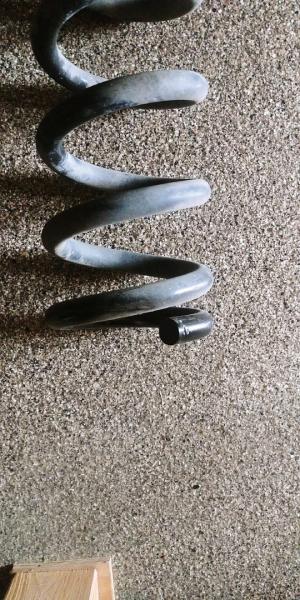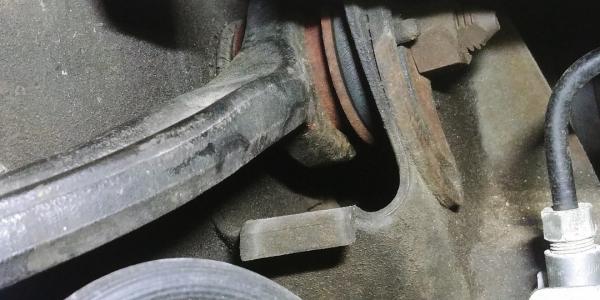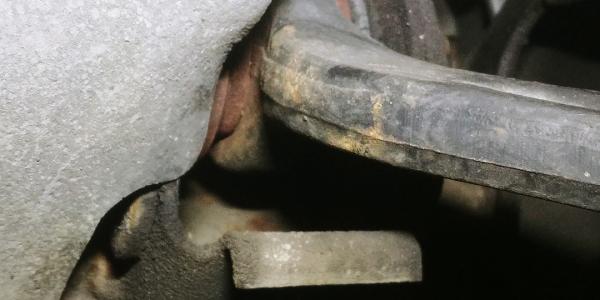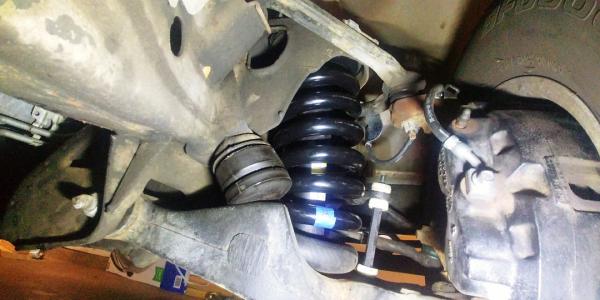This is about the suspension changes to our 2010 210P on the Express 3500 chassis. Current mileage 76k. Stock AR wheels and stock LT245/75R16 tires. It’s no secret that this era of vans are overloaded. I decided to improve the suspension on ours based on the excellent information in this forum. I’ve spent several weeks going through every related thread I could find since mid-2000’s (Booster, Hondo, Photog, etc.) including related website info, and I’ve compiled quite a few pages of notes. My sincere thanks for the information, hopefully what I post may help someone with a 210. I’ve used information posted from others in this thread - again, my appreciation to the authors.
The lb. weight tag on our van is front 4300 and rear 6084 but I have not weighed it on scales. I suspect that with fuel, water, supplies and a couple of passengers we’re knocking on the 10K door.
I’ve divided the work in the order that it was done for Front and Rear suspension groups.
Front Suspension – First Pass
The suspension RPO (for our van front L/R sides) is 6AL and 7AL. The GM coil spring listed for this RPO is the same as many of the 190’s – part #20760345. OEM GM shocks were installed about 4k miles ago and can still be considered as new shocks. Front steering, bushings etc are in good shape, with some parts replaced recently as maintenance. So I’m not trying to mask poor condition components here.
As posted by others:
OEM Spring
17.7" free height
6+ coils of probably 1.000" wire
Spring rate of about 1488lb/in based on ride height differences to known rate springs
Spring compressed 3.36"
Spring compressed height 14.34"
Baseline Height = 0”
The first thing I did was to install Black (medium duty) SumoSprings jounce bumpers on the front to replace the very tired OEM bumpers.
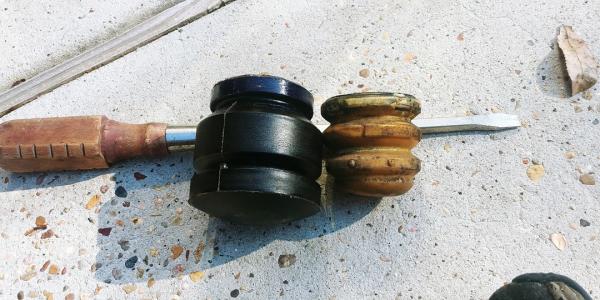
Ultimate goal is to raise the front about 2” – I agree with Booster’s view that the most efficient height increase is with spring replacement vs. adding spring spacers. Plus as mentioned, you’ve got to remove the spring either way. A 2” lift should not require shock extensions or other mods. The purpose of the SumoSprings is to provide a progressive full-stop of the front suspension, but not for the suspension to rely solely on them. I would like to see only a light bearing of the Sumosprings on the control arm instead of the more crunched look of them with the original coil springs.
One drawback - I stupidly overlooked taking LF and RF ground-to-fender lip measurements as a baseline, and the fender lip and Z-height dimensions now include whatever difference the new SumoSprings have made. As the van sat on its suspension, the Sumosprings were compressed by about half at the inner face and looked somewhat crunched. I’ve noticed a firmer set to the front as you would expect, but with a tendency to porpoise a bit. My guess, remembering the OEM bumpers, was that the new SumoSprings may have raised the front by .5” to 1”.
Current front heights of our van are LF 34.5”, RF 34” and the Z-height 3.5” (with Sumosprings). The info that Booster had given about Z and D factory heights applies to our van as well. Z height = 4.0” to 4.5”, preferred is 4.3”. D height = 5.3” to 6.1”, preferred is 5.7”. I believe (based on my guess) that prior to the Sumosprings installation, heights on our van were LF 33.5” to 34” and RF 33” to 33.5”, perhaps a bit higher than other numbers I’ve seen on the 190’s. But again, based on Booster’s info, the rear overhang, with genset, water tank and bumper spare, could pull up on that front a bit. Also as a guess, I’m thinking that Z-height prior to Sumosprings install may have been 2.5” to 3”. So a 2” lift from new coil springs would get me to the upper range of the Z-height before any spring settling. That seems to be acceptable, and of course an alignment would follow.
Rear Suspension
Our 210 sat fat and happy on the rear overload springs, so my next step was to install air bags. I didn’t expect to pull off of the overloads very much and that’s ok if the goal of supporting the body/frame more and lessening the crash over bumps can be achieved. I still have the option of doing what Booster did, which was removing the overload spring. I held that as last because I wanted to see if the ride could be improved just with airbags.
The part number of our rear OEM springs is 25756366, which seems to be the same as many 190’s. How Roadtrek ignored the 210 additional overhang and weights is beyond me, they could have easily spec’d the van with the heavier 22799639 spring packs.
As mentioned by other 210 owners, there is a 1.5” lift block installed that also has an extension for contact with the factory bump-stock. I needed to cut off the extension to provide space for the airbags – as part of this work I thought the best way was to remove the spacer for cutting, and then reinstall it. This also allowed me to replace the rusty crusty original u-bolts. New u-bolts came from Stengel Bros. The leaf springs are 2.5” wide and need 2.5625” inside dimension 5/8 in u-bolts. Length range for a 210 with spring spacer is 10.5” to 11.75” (OEM u-bolts are about 11.75” and a bit long). Incidentally, these long u-bolts take several repeat torques as they s-t-r-e-t-c-h. I did this over the course of several initial days and drives and will re-check until I see that the values stay consistent.
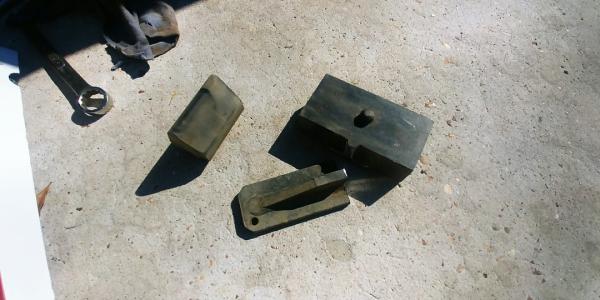
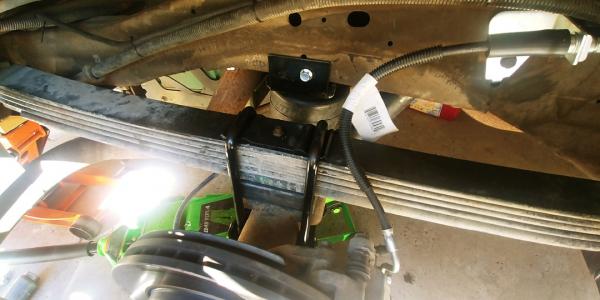
I installed the Air-Lift 88205 kit with internal jounce bumpers after reading of Booster’s experience with them. I like them as they serve several purposes with one installation. I plumbed them as individual units so LR and RR fender heights could be set up as needed, I may install an onboard compressor later on.

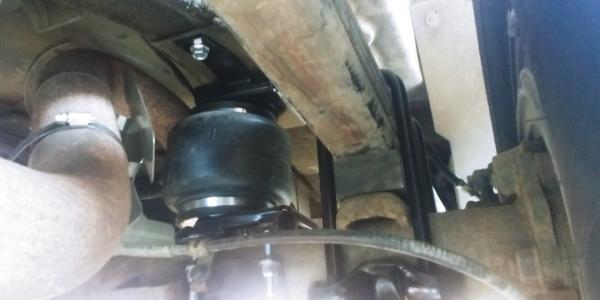
The D-height dimension on our van was 4.75” (driver side). LR fender lip height was 34.75” and RR fender lip height was 35”.
With no air, LR fender lip height went to 36.5”, RR fender lip height also went to 36.5”. I believe this may due to the airbag internal jounce bumper combined with airbag/brackets now taking up the space between frame and axle and perhaps evening out that original .25” difference side to side. So as has been noted, if there was a complete loss of air, the van still receives support from the airbags. I think the internal jounce bumper is a great idea.
I then put 25 psi into each airbag and checked the front fender lip heights. Rear fender lip heights went to 37.25”, LF went to 34.125” and RF went to 34.25” Prior to airbags, LF = 34.5”, RF = 34”. I’m not sure why the front number changed in this manner (realizing that raising the rear puts more downforce on the front). Perhaps one factor is the probably weak condition of the front coil springs not giving a consistent result? As you can see, there is a rake rear-to-front, which was expected. If there is a 2” lift in the front I believe the van will sit just fine and of course can be fine tuned with airbag pressure.
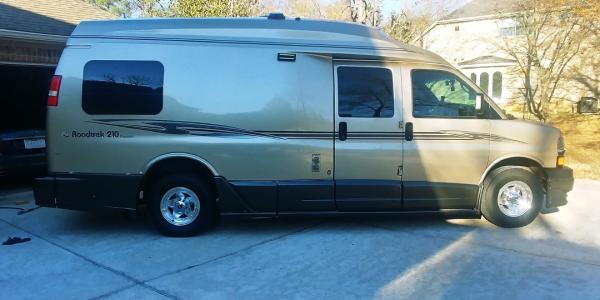
The leaf spring pack now sits slightly off the front ends of the overload leaf, which is good.
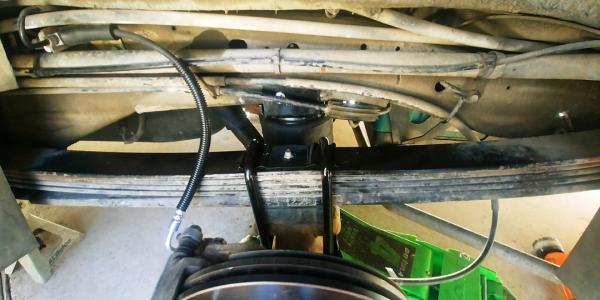
Driving impressions – based on the info I read, I expected some sort of driving improvement. But I was honestly not prepared for the fairly dramatic change in the suspension characteristics, so I’m subjectively calling this a big improvement in the back. There is still sway at corners, but much less than before the airbags. In particular, the crash of the rear suspension over bumps and bad roads is virtually eliminated, much more pleasant to drive. I suppose that the airbags are taking up the initial impact with air pressure and the internal jounce bumpers, then transferring a much-dissipated force to the leaf springs. I went over the same pre-airbag test route and the difference was very noticeable. I also noticed that the front suspension is working a bit harder, perhaps from the weight transfer and I could feel more of a rebound (porpoising) from the front SumoSprings. So all in all, in my opinion the Air-Lift kit is worth the time and money, wish I had done this a lot sooner. But I also think that a critical factor for overall improvement is to focus on both front and rear suspension in order to reach a balanced suspension operation. At this point the suspension did not have that balanced feel.
Front Suspension – Second Pass
The last part of the work now focused on front coil spring replacement. As stated, the goals were improved weight capability and Z-height increase, resulting in improved driveability. I also used the fender lip height measurements as a comparison.
So now it was on to figuring out which coil springs to use…
Incidentally, here’s a website that list cross-references to coil springs:
Pontotoc Part Number Interchange | Distributor Tools | MW Components
Col. 1 = MW Components (I think), Col. 2 = NAPA, Col 3 = Delco, Col. 4 = Moog
I used this info and the hundreds of forum posts to help verify spring data and to get to my final selection described below. You can find very specific and detailed information in those posts – far too many posts to list here. And as always, results can be very subjective so I’m just giving you my perspective.
I rejected the Tufftruck 1617 and 1618 setdowns as the more recent (2020+) threads indicated that there was more lift from these springs than the “original” 1617’s that Booster has installed into his 190.
Specs as posted on the original 1617’s:
17.7" free length-same as the OEM spring
8 coils of 1.050" wire
2026lb/in spring rate per Photog
Spring compression 2.5"
Spring compressed height 15.2"
Height change at wheelwell 2.0"
The last 1617 info I saw included a free height of 18” to 18.7”. I can’t be sure of the result of these springs, plus I’d rather install a spring without having to substantially compress it.
I rejected the Bill Erb spring as the results seemed to be all over the place.
I rejected the SumoSprings brand coil spring. Other than a description as a diesel engine version I couldn’t find actual specs.
I rejected the SC20470 spring (Moog 81006). I know another poster had installed these and noted a 2” height but the spec data didn’t appear to result in the goals I wanted. I couldn’t see that the wire diameter and free height made sense to result in the 2” height increase, also noted by Booster.
I rejected the Moog 81004, even though my choice would have been the 81004 as it initially gave the 2” height increase in prior years posts. However, later posts indicated an issue with too much height and justifiably wondering why the spring construction had seemingly changed.
My final choice was the Delco 45H0340 (19237856) which on paper is the same cross-reference spring as the 81004. I thought that if anyone would continue to require a standard spec, it would be an OEM mfg. as they would not want surprises at the dealer service installation stage. My rationale was that a supplier would (hopefully) produce a consistent Tier 1 spring for GM (I think it’s actually Eaton spring supplying?). Still a wing and a prayer, I was simply going by what I considered to be less risk. One additional note - the 81004 set is about $260, the Delco springs are $152. Even with shipping (Rockauto), the Delco springs are less than the “same” Moog springs.
Info posted by others:
Interchange part numbers:
Moog 81004
ACDelco 45H0340
Napa 277-3435
Husky SC20468
Raybestos 585-1340
ID: 4.068
Wire Dia: 1.031
Rate/Inch: 1570
Load at rated height: 5934
Rated compressed height: 14
Free length: 17.78
The new 45H0340 coils were delivered in a sealed AC-Delco box with the correct part number on it, made in USA. The springs themselves were not tagged so I could only hope that these were the right springs. But despite all my analysis I still hit a bump in the road – the free height of these new springs was 18.25”, or .5” more than the spec data showed, and higher than the stock 17.7” I was hoping for. Coil diameter was 1.03” and the distance between coils was .85” to 1.00”. Based on the information I’d seen, more coils can equal more lift but a more complacent ride, which would be ok.
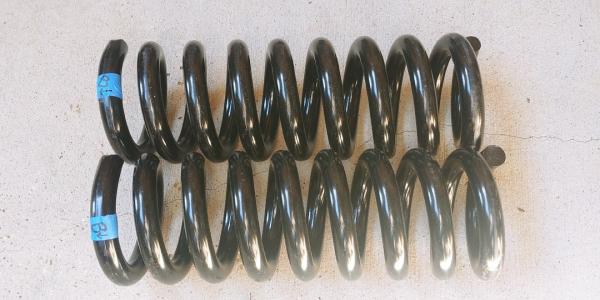
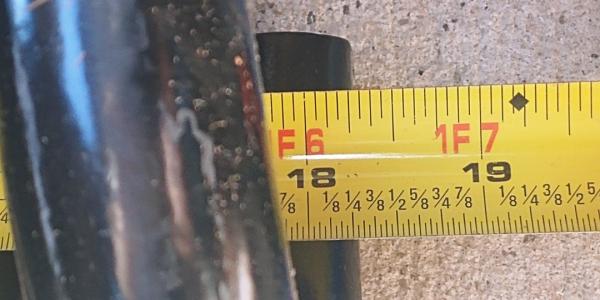
So now there was the question about the .5” difference in free height – combined with the number of coils would this increase the lift higher than the goal of 2”? Now what? After some thought I decided to trim a section of the bottom coils to get the free height to 17.75”. This wound up being about a third of a coil, and ended up with 8.5 coil count. Here’s why I decided to trim them:
• Based on recent (2018+) 1617 and 81004 information, there was never an issue with not enough height (2”) but there were comments about too much height (>2”). So even with these Delco springs, if I removed .5” of coil height I was perhaps avoiding excessive ride height increase over 2”.
• The top coil end was turned slightly down to the next coil and would need to remain that way to fit better into the (non-oriented) top coil insulator and frame cup. The lower coil keys into a slot in the lower control arm. After trimming part of the lower coil, the spring could easily just be turned slightly to fit into the lower control arm slot without any issue at the top fit.
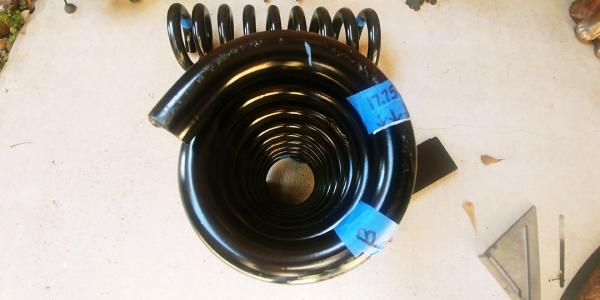
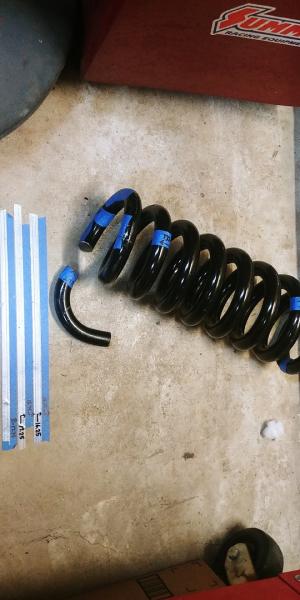
Trimming the spring coils was not a big deal, a few minutes with the cut-off wheel, but I had now moved into the I-hope-this-was-right stage. But at the same time I didn’t see where that small amount of trimming would drastically change anything except shave a bit of height off. I also added a section of 1” ID heater hose as an anti-rattle insulator on the bottom coil.
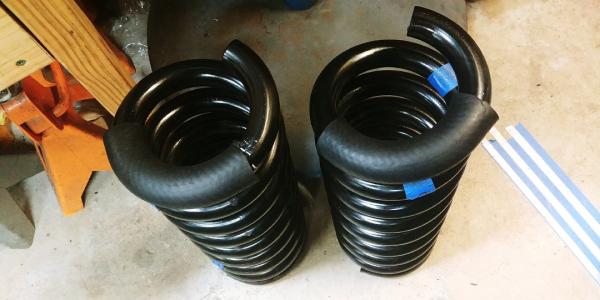
The van was taken to a local off-road shop for the coil spring replacement and alignment. I also took a new set of spring top insulators (Moog K160021) but we decided to re-use the original insulators as they were better construction and looked good. They fit fine onto the new springs.
Incidentally, the OEM springs averaged about 17.5” free height after their 11-year service.
After the new 45H0340 coil springs were installed came the moment of truth when the van was set back down and I breathed a sigh of relief. The following heights were noted:
Fender lip height: LF = 36.5”, RF = 36.5”, an increase of 2” to 2.5” which seemed to be on target.
Z-height changed to 4.8”, an increase of 1.3”. I’m expecting that the new springs may settle slightly, so after a road trip I’ll re-check.
The front Sumosprings are now lightly touching the control arm instead of looking like they are smashed into it – I think this is where they need to be to provide a more progressive response?
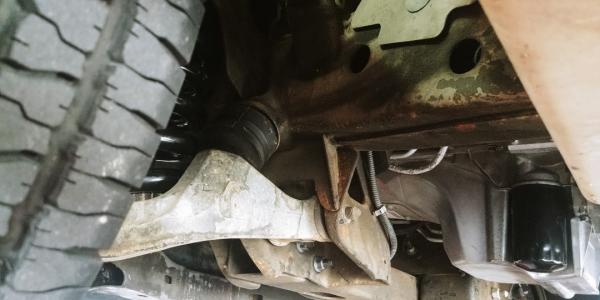
The rear bags were then adjusted (each side a little different) to bring the rear fender lip heights to 37” which gives a visual slight .5” rake. That’s a bit misleading though, as the vehicle frame itself was level as measured from the alignment hoist. Toe and camber only needed a slight adjustment, and all alignment specs were almost in the center of the specification ranges. I will also recheck the alignment again in later miles. We did a test drive with the tech, did a final adjustment on steering center, and I was then on my way.
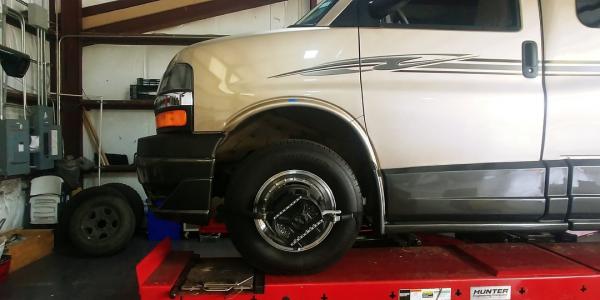
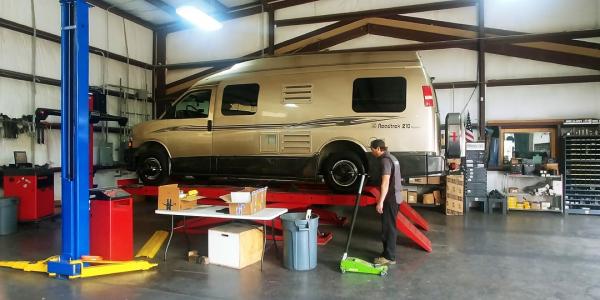
Overall Drive Impressions
I really do have to say the driving difference is night and day, to use a very overworked expression. But it’s true. Of course, this thing will never drive like a car but it feels like it finally has a working suspension system instead of crashing through bumps. Front tires 65 psi and rear tires 80 psi. Small bumps are felt but not especially harsh, maybe it’s the new shocks. I anticipate a later final step of Bilsteins all the way around as the currently installed GM shocks wear out. The installation shop felt that the rebound factor of the shocks may be their biggest weakness and recommended the Bilsteins which have also been mentioned in this forum many times.
There is no further porpoising, or pitching front to back over larger bumps. There is a bit of spring from the back I guess as the airbags compress/decompress, but it’s very small. It may also be the suspension slightly overpowering the rebound rate of the stock shocks. I wondered if the new coils would be too bouncy but they returned to static condition right away –again back to the shocks, I can see this happening as the shocks wear. Sway is much reduced and after a recent road trip in the Ft. Davis mountains (roads and wind), this is a big deal to me. So, in general the van feels more stable, absorbs bumps better and provides a much safer controllable feel. And there is adjustability with the rear air bags to compensate for different loading. At this time I don’t think I need to remove the overload leafs.
I was hesitant to modify the coils but I’m glad I did. With the trimming to free height spec of 17.75”, the amount removed was minor and after driving the van, I can’t really see a downside unless you went crazy with it or monkeyed with variable rate springs (these coils are constant rate). The key goal of increasing ride height was achieved and the ride quality is vastly improved over the original coils.
I would recommend these 210 modifications without hesitation for a much safer and enjoyable ride. Thank you again to this forum for the remarkable volume of information that enabled me to successfully complete this work.
The lb. weight tag on our van is front 4300 and rear 6084 but I have not weighed it on scales. I suspect that with fuel, water, supplies and a couple of passengers we’re knocking on the 10K door.
I’ve divided the work in the order that it was done for Front and Rear suspension groups.
Front Suspension – First Pass
The suspension RPO (for our van front L/R sides) is 6AL and 7AL. The GM coil spring listed for this RPO is the same as many of the 190’s – part #20760345. OEM GM shocks were installed about 4k miles ago and can still be considered as new shocks. Front steering, bushings etc are in good shape, with some parts replaced recently as maintenance. So I’m not trying to mask poor condition components here.
As posted by others:
OEM Spring
17.7" free height
6+ coils of probably 1.000" wire
Spring rate of about 1488lb/in based on ride height differences to known rate springs
Spring compressed 3.36"
Spring compressed height 14.34"
Baseline Height = 0”
The first thing I did was to install Black (medium duty) SumoSprings jounce bumpers on the front to replace the very tired OEM bumpers.

Ultimate goal is to raise the front about 2” – I agree with Booster’s view that the most efficient height increase is with spring replacement vs. adding spring spacers. Plus as mentioned, you’ve got to remove the spring either way. A 2” lift should not require shock extensions or other mods. The purpose of the SumoSprings is to provide a progressive full-stop of the front suspension, but not for the suspension to rely solely on them. I would like to see only a light bearing of the Sumosprings on the control arm instead of the more crunched look of them with the original coil springs.
One drawback - I stupidly overlooked taking LF and RF ground-to-fender lip measurements as a baseline, and the fender lip and Z-height dimensions now include whatever difference the new SumoSprings have made. As the van sat on its suspension, the Sumosprings were compressed by about half at the inner face and looked somewhat crunched. I’ve noticed a firmer set to the front as you would expect, but with a tendency to porpoise a bit. My guess, remembering the OEM bumpers, was that the new SumoSprings may have raised the front by .5” to 1”.
Current front heights of our van are LF 34.5”, RF 34” and the Z-height 3.5” (with Sumosprings). The info that Booster had given about Z and D factory heights applies to our van as well. Z height = 4.0” to 4.5”, preferred is 4.3”. D height = 5.3” to 6.1”, preferred is 5.7”. I believe (based on my guess) that prior to the Sumosprings installation, heights on our van were LF 33.5” to 34” and RF 33” to 33.5”, perhaps a bit higher than other numbers I’ve seen on the 190’s. But again, based on Booster’s info, the rear overhang, with genset, water tank and bumper spare, could pull up on that front a bit. Also as a guess, I’m thinking that Z-height prior to Sumosprings install may have been 2.5” to 3”. So a 2” lift from new coil springs would get me to the upper range of the Z-height before any spring settling. That seems to be acceptable, and of course an alignment would follow.
Rear Suspension
Our 210 sat fat and happy on the rear overload springs, so my next step was to install air bags. I didn’t expect to pull off of the overloads very much and that’s ok if the goal of supporting the body/frame more and lessening the crash over bumps can be achieved. I still have the option of doing what Booster did, which was removing the overload spring. I held that as last because I wanted to see if the ride could be improved just with airbags.
The part number of our rear OEM springs is 25756366, which seems to be the same as many 190’s. How Roadtrek ignored the 210 additional overhang and weights is beyond me, they could have easily spec’d the van with the heavier 22799639 spring packs.
As mentioned by other 210 owners, there is a 1.5” lift block installed that also has an extension for contact with the factory bump-stock. I needed to cut off the extension to provide space for the airbags – as part of this work I thought the best way was to remove the spacer for cutting, and then reinstall it. This also allowed me to replace the rusty crusty original u-bolts. New u-bolts came from Stengel Bros. The leaf springs are 2.5” wide and need 2.5625” inside dimension 5/8 in u-bolts. Length range for a 210 with spring spacer is 10.5” to 11.75” (OEM u-bolts are about 11.75” and a bit long). Incidentally, these long u-bolts take several repeat torques as they s-t-r-e-t-c-h. I did this over the course of several initial days and drives and will re-check until I see that the values stay consistent.


I installed the Air-Lift 88205 kit with internal jounce bumpers after reading of Booster’s experience with them. I like them as they serve several purposes with one installation. I plumbed them as individual units so LR and RR fender heights could be set up as needed, I may install an onboard compressor later on.


The D-height dimension on our van was 4.75” (driver side). LR fender lip height was 34.75” and RR fender lip height was 35”.
With no air, LR fender lip height went to 36.5”, RR fender lip height also went to 36.5”. I believe this may due to the airbag internal jounce bumper combined with airbag/brackets now taking up the space between frame and axle and perhaps evening out that original .25” difference side to side. So as has been noted, if there was a complete loss of air, the van still receives support from the airbags. I think the internal jounce bumper is a great idea.
I then put 25 psi into each airbag and checked the front fender lip heights. Rear fender lip heights went to 37.25”, LF went to 34.125” and RF went to 34.25” Prior to airbags, LF = 34.5”, RF = 34”. I’m not sure why the front number changed in this manner (realizing that raising the rear puts more downforce on the front). Perhaps one factor is the probably weak condition of the front coil springs not giving a consistent result? As you can see, there is a rake rear-to-front, which was expected. If there is a 2” lift in the front I believe the van will sit just fine and of course can be fine tuned with airbag pressure.

The leaf spring pack now sits slightly off the front ends of the overload leaf, which is good.

Driving impressions – based on the info I read, I expected some sort of driving improvement. But I was honestly not prepared for the fairly dramatic change in the suspension characteristics, so I’m subjectively calling this a big improvement in the back. There is still sway at corners, but much less than before the airbags. In particular, the crash of the rear suspension over bumps and bad roads is virtually eliminated, much more pleasant to drive. I suppose that the airbags are taking up the initial impact with air pressure and the internal jounce bumpers, then transferring a much-dissipated force to the leaf springs. I went over the same pre-airbag test route and the difference was very noticeable. I also noticed that the front suspension is working a bit harder, perhaps from the weight transfer and I could feel more of a rebound (porpoising) from the front SumoSprings. So all in all, in my opinion the Air-Lift kit is worth the time and money, wish I had done this a lot sooner. But I also think that a critical factor for overall improvement is to focus on both front and rear suspension in order to reach a balanced suspension operation. At this point the suspension did not have that balanced feel.
Front Suspension – Second Pass
The last part of the work now focused on front coil spring replacement. As stated, the goals were improved weight capability and Z-height increase, resulting in improved driveability. I also used the fender lip height measurements as a comparison.
So now it was on to figuring out which coil springs to use…
Incidentally, here’s a website that list cross-references to coil springs:
Pontotoc Part Number Interchange | Distributor Tools | MW Components
Col. 1 = MW Components (I think), Col. 2 = NAPA, Col 3 = Delco, Col. 4 = Moog
I used this info and the hundreds of forum posts to help verify spring data and to get to my final selection described below. You can find very specific and detailed information in those posts – far too many posts to list here. And as always, results can be very subjective so I’m just giving you my perspective.
I rejected the Tufftruck 1617 and 1618 setdowns as the more recent (2020+) threads indicated that there was more lift from these springs than the “original” 1617’s that Booster has installed into his 190.
Specs as posted on the original 1617’s:
17.7" free length-same as the OEM spring
8 coils of 1.050" wire
2026lb/in spring rate per Photog
Spring compression 2.5"
Spring compressed height 15.2"
Height change at wheelwell 2.0"
The last 1617 info I saw included a free height of 18” to 18.7”. I can’t be sure of the result of these springs, plus I’d rather install a spring without having to substantially compress it.
I rejected the Bill Erb spring as the results seemed to be all over the place.
I rejected the SumoSprings brand coil spring. Other than a description as a diesel engine version I couldn’t find actual specs.
I rejected the SC20470 spring (Moog 81006). I know another poster had installed these and noted a 2” height but the spec data didn’t appear to result in the goals I wanted. I couldn’t see that the wire diameter and free height made sense to result in the 2” height increase, also noted by Booster.
I rejected the Moog 81004, even though my choice would have been the 81004 as it initially gave the 2” height increase in prior years posts. However, later posts indicated an issue with too much height and justifiably wondering why the spring construction had seemingly changed.
My final choice was the Delco 45H0340 (19237856) which on paper is the same cross-reference spring as the 81004. I thought that if anyone would continue to require a standard spec, it would be an OEM mfg. as they would not want surprises at the dealer service installation stage. My rationale was that a supplier would (hopefully) produce a consistent Tier 1 spring for GM (I think it’s actually Eaton spring supplying?). Still a wing and a prayer, I was simply going by what I considered to be less risk. One additional note - the 81004 set is about $260, the Delco springs are $152. Even with shipping (Rockauto), the Delco springs are less than the “same” Moog springs.
Info posted by others:
Interchange part numbers:
Moog 81004
ACDelco 45H0340
Napa 277-3435
Husky SC20468
Raybestos 585-1340
ID: 4.068
Wire Dia: 1.031
Rate/Inch: 1570
Load at rated height: 5934
Rated compressed height: 14
Free length: 17.78
The new 45H0340 coils were delivered in a sealed AC-Delco box with the correct part number on it, made in USA. The springs themselves were not tagged so I could only hope that these were the right springs. But despite all my analysis I still hit a bump in the road – the free height of these new springs was 18.25”, or .5” more than the spec data showed, and higher than the stock 17.7” I was hoping for. Coil diameter was 1.03” and the distance between coils was .85” to 1.00”. Based on the information I’d seen, more coils can equal more lift but a more complacent ride, which would be ok.


So now there was the question about the .5” difference in free height – combined with the number of coils would this increase the lift higher than the goal of 2”? Now what? After some thought I decided to trim a section of the bottom coils to get the free height to 17.75”. This wound up being about a third of a coil, and ended up with 8.5 coil count. Here’s why I decided to trim them:
• Based on recent (2018+) 1617 and 81004 information, there was never an issue with not enough height (2”) but there were comments about too much height (>2”). So even with these Delco springs, if I removed .5” of coil height I was perhaps avoiding excessive ride height increase over 2”.
• The top coil end was turned slightly down to the next coil and would need to remain that way to fit better into the (non-oriented) top coil insulator and frame cup. The lower coil keys into a slot in the lower control arm. After trimming part of the lower coil, the spring could easily just be turned slightly to fit into the lower control arm slot without any issue at the top fit.


Trimming the spring coils was not a big deal, a few minutes with the cut-off wheel, but I had now moved into the I-hope-this-was-right stage. But at the same time I didn’t see where that small amount of trimming would drastically change anything except shave a bit of height off. I also added a section of 1” ID heater hose as an anti-rattle insulator on the bottom coil.

The van was taken to a local off-road shop for the coil spring replacement and alignment. I also took a new set of spring top insulators (Moog K160021) but we decided to re-use the original insulators as they were better construction and looked good. They fit fine onto the new springs.
Incidentally, the OEM springs averaged about 17.5” free height after their 11-year service.
After the new 45H0340 coil springs were installed came the moment of truth when the van was set back down and I breathed a sigh of relief. The following heights were noted:
Fender lip height: LF = 36.5”, RF = 36.5”, an increase of 2” to 2.5” which seemed to be on target.
Z-height changed to 4.8”, an increase of 1.3”. I’m expecting that the new springs may settle slightly, so after a road trip I’ll re-check.
The front Sumosprings are now lightly touching the control arm instead of looking like they are smashed into it – I think this is where they need to be to provide a more progressive response?

The rear bags were then adjusted (each side a little different) to bring the rear fender lip heights to 37” which gives a visual slight .5” rake. That’s a bit misleading though, as the vehicle frame itself was level as measured from the alignment hoist. Toe and camber only needed a slight adjustment, and all alignment specs were almost in the center of the specification ranges. I will also recheck the alignment again in later miles. We did a test drive with the tech, did a final adjustment on steering center, and I was then on my way.


Overall Drive Impressions
I really do have to say the driving difference is night and day, to use a very overworked expression. But it’s true. Of course, this thing will never drive like a car but it feels like it finally has a working suspension system instead of crashing through bumps. Front tires 65 psi and rear tires 80 psi. Small bumps are felt but not especially harsh, maybe it’s the new shocks. I anticipate a later final step of Bilsteins all the way around as the currently installed GM shocks wear out. The installation shop felt that the rebound factor of the shocks may be their biggest weakness and recommended the Bilsteins which have also been mentioned in this forum many times.
There is no further porpoising, or pitching front to back over larger bumps. There is a bit of spring from the back I guess as the airbags compress/decompress, but it’s very small. It may also be the suspension slightly overpowering the rebound rate of the stock shocks. I wondered if the new coils would be too bouncy but they returned to static condition right away –again back to the shocks, I can see this happening as the shocks wear. Sway is much reduced and after a recent road trip in the Ft. Davis mountains (roads and wind), this is a big deal to me. So, in general the van feels more stable, absorbs bumps better and provides a much safer controllable feel. And there is adjustability with the rear air bags to compensate for different loading. At this time I don’t think I need to remove the overload leafs.
I was hesitant to modify the coils but I’m glad I did. With the trimming to free height spec of 17.75”, the amount removed was minor and after driving the van, I can’t really see a downside unless you went crazy with it or monkeyed with variable rate springs (these coils are constant rate). The key goal of increasing ride height was achieved and the ride quality is vastly improved over the original coils.
I would recommend these 210 modifications without hesitation for a much safer and enjoyable ride. Thank you again to this forum for the remarkable volume of information that enabled me to successfully complete this work.

